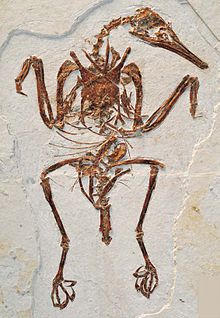Enantiornithes
Enantiornithes sunt un grup dispărut de avialae („păsări“, în sens larg), cel mai abundent grup divers și cunoscut din era Mezozoică.[3][4][5] Ca multe alte păsări primitive, cele mai multe enantiornite aveau aripi echipate cu gheare și o gură cu dinți, dar altfel semănau mult cu niște păsări moderne în exterior. Enantiornitele au dispărut la granița Cretacic-Paleogen, împreună cu hesperornitidele și toți ceilalți dinozauri non-aviari. Se crede că nu au descendenți vii.
| Enantiornithes Fosilă: Cretacic timpuriu–Cretacic târziu, 145.5–66.0 mln. ani în urmă | |
|---|---|

| |
| Rapaxavis pani | |
| Clasificare științifică | |
| Regn: | Animalia |
| Încrengătură: | Chordata |
| Clasă: | Sauropsida |
| Subclasă: | Enantiornithes |
| Subgrupuri | |
| Modifică text |
|
Note
modificare- ^ Wang, Min; Zhou, Zhong-He; O'Connor, Jingmai K.; Zelenkov, Nikita V. (). „A new diverse enantiornithine family (Bohaiornithidae fam. nov.) from the Lower Cretaceous of China with information from two new species” (PDF). Vertebrata PalAsiatica. 52 (1): 31–76.
- ^ Wang, X.; O'Connor, J. K.; Zheng, X.; Wang, M.; Hu, H.; Zhou, Z. (). „Insights into the evolution of rachis dominated tail feathers from a new basal enantiornithine (Aves: Ornithothoraces)”. Biological Journal of the Linnean Society. 113 (3): 805–819. doi:10.1111/bij.12313.
- ^ Chiappe, Luis M.; Walker, Cyril A. (). „Skeletal Morphology and Systematics of the Cretaceous Euenantiornithes (Ornithothoraces: Enantiornithes)”. În Chiappe, Luis M.; Witmer, Lawrence M. Mesozoic Birds: Above the Heads of Dinosaurs. University of California Press. pp. 240–67. ISBN 978-0-520-20094-4.
- ^ Chiappe, Luis M. (). Glorified Dinosaurs: The Origin and Early Evolution of Birds. Hoboken, New Jersey: John Wiley and Sons. ISBN 978-0-471-24723-4.[necesită pagina]
- ^ O'Connor, Jingmai K.; Chiappe, Luis M.; Gao, Chunling; Zhao, Bo (). „Anatomy of the Early Cretaceous enantiornithine bird Rapaxavis pani” (PDF). Acta Palaeontologica Polonica. 56 (3): 463–75. doi:10.4202/app.2010.0047.